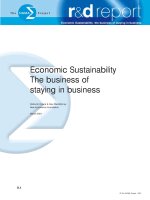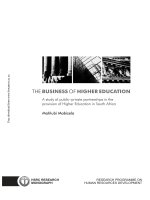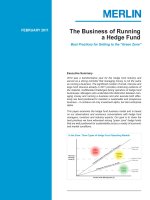The BUsiness of TV production
Bạn đang xem bản rút gọn của tài liệu. Xem và tải ngay bản đầy đủ của tài liệu tại đây (2.04 MB, 448 trang )
This page intentionally left blank
The Business of TV Production
The Business of TV Production provides an insider’s view of television production from
initial concept to developing, creating and airing the final program. It outlines the main
functions of each of the players involved and the key stages of the production process.
Covering all genres of television – drama and comedy, documentary and current
affairs, infotainment and reality TV – it deals with the business side of production
and provides context for all aspects of the operation and the challenges of each genre,
such as funding, sourcing a creative team, and marketing and distribution.
This book is for all students taking courses in television production and for those
in the industry wanting to upgrade their skills.
Craig Collie is a freelance producer and consultant. He has been working in the
television industry since 1969, both in production and network management. He
has designed the television production curriculums at Queensland University of
Technology, and been executive in charge of student production at the Australian
Film Television and Radio School (AFTRS).
The Business of
TV Production
Craig Collie
CAMBRIDGE UNIVERSITY PRESS
Cambridge, New York, Melbourne, Madrid, Cape Town, Singapore, São Paulo
Cambridge University Press
The Edinburgh Building, Cambridge CB2 8RU, UK
Published in the United States of America by Cambridge University Press, New York
www.cambridge.org
Information on this title: www.cambridge.org/9780521682381
© Craig Collie 2007
This publication is in copyright. Subject to statutory exception and to the provision of
relevant collective licensing agreements, no reproduction of any part may take place
without the written permission of Cambridge University Press.
First published in print format 2007
eBook (EBL)
ISBN-13 978-0-511-29497-6
ISBN-10 0-511-29497-2
eBook (EBL)
ISBN-13
ISBN-10
paperback
978-0-521-68238-1
paperback
0-521-68238-X
Cambridge University Press has no responsibility for the persistence or accuracy of urls
for external or third-party internet websites referred to in this publication, and does not
guarantee that any content on such websites is, or will remain, accurate or appropriate.
Contents
Preface
xii
Diagrams and tables
Abbreviations
xv
xvii
Part A Opiate of the people: the television industry
Chapter 1 Origins and growth of a global medium 3
1.1 John Logie Baird and the race to broadcast
1.2 America sets the agenda 10
1.3 The ideal of public television 14
1.4 The coming of cable and satellite 18
1.5 Decline of the US networks 19
Sources and further reading 21
Chapter 2 The
2.1
2.2
2.3
2.4
2.5
2.6
2.7
2.8
digital revolution 23
Freeing up spectrum for auction 24
Benefits of digital broadcasting 26
High-definition television 28
Widescreen picture 29
Multichannelling 30
Enhanced services 33
Interactivity 35
Convergence 36
Sources and further reading 37
Chapter 3 The
3.1
3.2
3.3
3.4
3.5
3.6
industry in Australia 39
Consolidation of a dual system 40
The commercial free-to-air sector 42
The two public broadcasters 45
Changing patterns of programming 49
The third player: pay television 52
The transition to digital television 56
1
6
vi
Contents
3.7
Regulatory and infrastructure changes
Sources and further reading 58
57
Chapter 4 Television genres 60
4.1 Drama 61
4.2 Comedy 62
4.3 Documentary 64
4.4 Current affairs 66
4.5 News 66
4.6 Sport 67
4.7 Infotainment, lifestyle and magazine programs
4.8 Variety and entertainment 69
4.9 Reality programs 70
4.10 Music 72
4.11 Children’s programs 73
4.12 Animation 73
Sources and further reading 75
Part B Massage parlour: development and funding
of a project 77
Chapter 5 The
5.1
5.2
5.3
5.4
5.5
5.6
5.7
concept 79
The role of the producer 79
Sources of the concept 82
Is it a good idea and who else thinks so? 83
It’s a concept, but is it a program? 84
A market for the program 86
Optioning an existing work 88
The stages of production that follow 89
Sources and further reading 92
Chapter 6 Development of the project 93
6.1 The development team 95
6.2 Contract with the development team 96
6.3 Chain of Title 97
6.4 Fee deferral 99
6.5 The development budget 100
6.6 Development funding 102
6.7 The proposal document 106
6.8 Choice of format 111
6.9 Estimate of the production budget 112
6.10 Pilots 113
Sources and further reading 115
Chapter 7 Approaches to genre development 116
7.1 Drama characters and setting 116
7.2 The drama treatment 118
7.3 Turning story into screenplay 119
7.4 Critical assessment of script drafts 123
68
Contents
7.5
7.6
7.7
7.8
7.9
When things aren’t working 125
Documentary development 126
Program research 128
Development of reality programs 130
Other genres 132
Sources and further reading 133
Chapter 8 The pursuit of funding 134
8.1 Australian free-to-air broadcasters 135
8.2 Australian pay television 139
8.3 Overseas broadcasters 140
8.4 Distribution advance or guarantee 141
8.5 Film Finance Corporation 142
8.6 Other government agency funding 145
8.7 Private investment 148
8.8 Division 10BA and 10B tax deduction schemes
8.9 Film-Licensed Investment Companies 152
8.10 Corporate investment 153
8.11 Production funding contracts 155
8.12 Completion guarantee 156
Sources and further reading 157
Chapter 9 Management of a creative project 158
9.1 The qualities of a producer 159
9.2 Choosing the right team 159
9.3 Production team interaction 160
9.4 The producer–director relationship 161
9.5 The team with a leader 162
9.6 Negotiation skills 164
9.7 Knowing how production works 166
9.8 Networking 167
9.9 Building a business 168
9.10 Ethics 169
9.11 Risk taking and commercial prudence 170
Sources and further reading 171
Chapter 10 Multi-platform projects 172
10.1 Established merchandising 173
10.2 Online platforms 174
10.3 Mobile (hand-held) platforms 177
10.4 Range of rights 179
Sources and further reading 179
Chapter 11 Marketing and distribution 181
11.1 Marketing options 182
11.2 Publicity materials 183
11.3 The television marketplace 185
11.4 Marketing beyond television 188
11.5 The video market 189
150
vii
viii
Contents
11.6 Rights management 190
Sources and further reading
191
Part C Riding the tiger: management of the production
Chapter 12 Commencement of pre-production 195
12.1 Key production personnel 196
12.2 The production base 198
12.3 Script breakdown 198
12.4 Refining the production budget 201
12.5 Timing the script 201
12.6 Pre-production schedule 202
Chapter 13 Documentation and office systems 204
13.1 Office systems 204
13.2 Financial organisation 206
13.3 Regular reporting 210
13.4 Insurance 211
13.5 Cast and crew contracts 214
13.6 Script amendments 214
13.7 Safety Report 215
13.8 Daily production paperwork 216
Sources and further reading 220
Chapter 14 Crew, equipment and facilities 221
14.1 Choices of format 221
14.2 The camera crew 224
14.3 Hiring of crew 227
14.4 Audio crew and equipment 228
14.5 Lighting and grips 229
14.6 Art department 230
14.7 Advisors and consultants 234
Sources and further reading 235
Chapter 15 Casting, rehearsal and performance 236
15.1 Types of performers 237
15.2 Script breakdown and cast scheduling
15.3 Casting 241
15.4 Stunt performers 243
15.5 Casting of children 244
15.6 Rehearsals 246
15.7 Performance on screen 247
15.8 Casting for reality television 249
15.9 Casting for documentary 250
Sources and further reading 251
Chapter 16 Locations 252
16.1 Locations and sets 253
16.2 The search for locations 254
238
193
Contents
16.3
16.4
16.5
16.6
16.7
16.8
Authorities to approach 255
Geographical spread 256
The location agreement 257
Location surveys 258
Documentary locations 259
Filming on Indigenous land 260
Sources and further reading 264
Chapter 17 Travel arrangements 265
17.1 Getting there 266
17.2 Getting around on location 267
17.3 Documentation for overseas travel 268
17.4 Accommodation and meals 270
17.5 Unfamiliar cultures 272
17.6 Minders, fixers and drivers 273
17.7 Dangerous assignments 274
Sources and further reading 276
Chapter 18 Drafting the production budget 277
18.1 AFC budget format 278
18.2 Story and script 280
18.3 Development costs 282
18.4 Producers, directors and principal cast
18.5 Below the Line costs 284
18.6 Production fees and salaries 285
18.7 Overtime and loadings 286
18.8 Fringe calculations 287
18.9 Cast 289
18.10 Materials costs 291
18.11 Location costs 292
18.12 Equipment and stores 293
18.13 Travel and transport 294
18.14 Insurance 296
18.15 Post-production 297
18.16 Finance and legal 298
18.17 Contingency 299
Sources and further reading 299
Chapter 19 Scheduling the shoot 300
19.1 General principles of scheduling 301
19.2 Minimising travelling costs 302
19.3 Use of a location 303
19.4 Wet weather cover 304
19.5 Cast considerations 305
19.6 Timing of the shoot 306
19.7 Updating the schedule 307
19.8 Scheduling actuality shoots 308
Sources and further reading 309
282
ix
x
Contents
Chapter 20 Preparing studio and outside broadcast productions 310
20.1 Layout of the studio 311
20.2 The planning stage 312
20.3 Consolidation of pre-production 317
20.4 Rehearsal 318
20.5 Studio guests and live audiences 319
20.6 Outside broadcast production 321
Sources and further reading 324
Chapter 21 Management of the shoot 325
21.1 Monitor progress, deal with the problems
21.2 Review of footage shot 327
21.3 Production safety 327
21.4 Impact on the budget 329
Sources and further reading 330
325
Chapter 22 Management of the production budget 331
22.1 Some basic accounting principles 332
22.2 Cost Reports 335
22.3 Offsets 340
22.4 Reporting to investors and others 342
Sources and further reading 343
Chapter 23 Post-production through to delivery 344
23.1 Role of the producer 345
23.2 The three historical phases of post-production 346
23.3 Linear editing 347
23.4 Non-linear editing 348
23.5 Archive and other sourced footage 352
23.6 Computer-generated effects and animation 353
23.7 The art of editing 354
23.8 Music 355
23.9 Audio post-production 356
23.10 Sound aesthetics 357
23.11 Editing factual programs 358
23.12 Delivery materials 360
Sources and further reading 361
Part D A nod to the gatekeepers: the environment
of television 363
Chapter 24 Building the television schedule 365
24.1 Schedule layout 366
24.2 Scheduling influences 370
24.3 Audience research 373
24.4 Commissioning for the schedule 375
Sources and further reading 375
Chapter 25 Legal constraints on content 376
25.1 What is copyright? 376
Contents
25.2
25.3
25.4
25.5
25.6
25.7
25.8
25.9
25.10
25.11
Rights of copyright owners 380
Infringement of copyright 382
Copyright collecting societies 384
Other aspects of copyright 385
Confidential information 386
Defamation 388
The law of contempt 390
Offensive material 392
Classification of television programs
Privacy and trespass 396
Sources and further reading 397
Chapter 26 Business structure and operation 398
26.1 Sole traders 400
26.2 Private companies 400
26.3 Trust companies 404
26.4 Partnerships 404
26.5 Joint ventures 406
26.6 Setting up an office 407
26.7 The ABN and business name 408
26.8 Goods and services tax 410
26.9 PAYG withholding 411
26.10 The status of workers 412
26.11 Payroll tax 414
26.12 Other taxes 415
26.13 Superannuation 416
26.14 Insurance 416
26.15 The list goes on 417
Sources and further reading 417
Index
418
393
xi
Preface
The business of television production is all about creative management and the
management of creativity. At its heart lie the conventional canons of good management – financial control, people management, inputs, legal oversight and so
on – but overlying this is a need for considerable flexibility. No matter how much
market research is done, no-one has any real idea whether a television program
will work or not. And production costs are equally unreliable, subject to weather
disruption, sulking actors and members of the public who have lost interest in
being on camera. It is possibly the only manufacturing industry that conventionally puts a contingency into its production budget.
On the other side of the television coin is the management of the creative
process. Sometimes the people are brilliantly and erratically creative, sometimes
they are the only people in the world with any regard for their ability. They can
be dishonest, backstabbing egomaniacs. Or they can be cool, calm and collected
professionals who know exactly how to carry out their craft in a way that adds
immeasurably to the quality of the program. They can be the source of lifelong
friendships.
The television industry is an industry of paradoxes. Television programs are
made, for the most part, for networks that are extraordinarily risk averse, when
their own interest is best served by taking risk, and whose commissioning executives often seem to make decisions based on anything but the quality of the
program proposal.
So why do people expose themselves to this degree of uncertainty and randomness? Why have I done so for over thirty-five years? Because it is perversely
rewarding and because the challenge of steering a production through all the pitfalls that lie in waiting calls on all your accumulated wisdom and experience. You
learn how to anticipate many of the traps and to negotiate your way around them.
You take a pride in your professionalism.
This book is designed to give the reader an insight into the process of converting
a curious idea into an immensely satisfying and, hopefully, successful television
program. It is written from the point of view of the producer, the poor fool charged
with steering the ship of production through to its destination, and it is an insider’s
view. The story of the business of television production is the story of the producer.
It’s as simple as that.
xii
Preface
xiii
Most tertiary courses in media, communications, film and television – call them
what you will – focus on teaching the creative crafts of production: camerawork,
editing and, everyone’s aim in the business it seems, directing. I’m not convinced
that these areas can be taught to any great extent beyond basic operational skills,
and these are often glossed over in favour of more time spent on aesthetics and
analysis. With increasing demand for these courses to have greater connection to
industry, there is a growing interest in the business side of television production.
At the least, this side lends itself to the processes of teaching, although even then
it has its limits. There are basic operations and basic knowledge to learn, but
ultimately even the business side of television is about judgement and instinct.
That cannot be taught. It is partly already there (or not, as the case may be)
and partly accumulated through experience. This book is, first and foremost, a
textbook at the tertiary education level, but I hope it would serve a useful purpose
as well as a primer for those already in the industry who want to upgrade their
skills to try their hand at producing.
There are three main aspects to the book, covering the three sets of skills
required in the business of production. First, it is about people management
and, through the leadership of the production team, maintaining an editorial
and creative focus in all the contributing craft skills that are woven into a finished
television program. These skills are common to any television production anywhere in the world, the universal qualities required of a television producer. The
second aspect is how to determine and obtain the necessary resources to ensure
the best possible program will be made for the funds available to it. The most
crucial resource is, of course, money. This knowledge is specific to the country in
which the program is being made. An Australian production needs to know what
resources are available and how they are used in Australia, how the conventions
of production work in Australia, and what the industry structure and culture is
that prevails in Australia. The third aspect is knowing the steps along the production path from concept to delivery, what the role of each step is, and how it might
be modified for the specific needs of each production. A triumvirate of people,
resources and process.
This book is not a checklist of the things to do to take a production down some
standard pathway. That would be a misrepresentation of the way the profession
of production operates. There is no prescription for making a television program.
Every program is different. Every production within a particular genre is different from the other productions in that genre, but not as different as from the
productions in other genres. There are conventions that are generally useful to
follow or adapt as long as they serve the particular needs of the program. Where
they don’t, the production process should be amended so it does suit those needs.
Each production pathway is planned with a mix of experience and judgement.
The guiding principle is: know what is generally done, then do what will work
best for the program.
If there’s no one way to make a television program, it’s important that a book
such as this doesn’t reflect the experience of just one producer. This is not about
my approach to television production, although elements of that are inevitably
part of it. I have endeavoured to bring together a consensus of experiences of
various participants in the industry with a wide range of approaches. I have tried
to weave this aggregated experience through the common narrative of production.
xiv
Preface
I’d like to particularly note and to thank Sue Murray (Fandango Australia) and
Ian Collie (Essential Viewing), who read and gave critical feedback on selected
chapters, Peter Herbert (AFTRS) and John Eastway (Eastway Communication),
with whom I had several discussions about what being a producer is all about, and
for the insights into their particular areas of experience and expertise (in no particular order): Peter Abbott (Freehand Group), Paddy Conroy and Bob Donoghue
(Ovation), Fiona Gilroy and Erika Honey (SBS Marketing), Peter George (producer), Paul Vincent (SBS), Tina Braham and Chris Spry (The Lab), David Vadiveloo (producer), David Goldie (Goldie Media), Ben Cunningham (Austar), Fiona
Crago (Beyond Distribution), John Russell (Essential Viewing), and no doubt others I have accidentally overlooked. There are a number of publications whose
views I have incorporated into the body of the book. They are listed at the end
of chapters. There are also the people I have worked with over the last thirtyfive years who have contributed to my growing understanding of the production
process and, of course, my family and my wife, Jan, whose support and encouragement have made the task that much easier. Lastly, my thanks to Alan McKee
of Queensland University of Technology for suggesting me to Cambridge University Press to write this book, to Cambridge University Press and Jill Henry for
their faith, hopefully not misplaced, that I could, and to the editor, Carolyn Pike,
for ironing out the bumps and making the book better than it was when I first
wrote it.
Diagrams and tables
page
Figure 2.1 Presentation of 4:3 and 16:9 aspect ratios on incompatible
screens.
Figure 5.1 Generalised television production pathway from concept to
delivery.
Figure 6.1 Pathway of program development.
Figure 7.1 Sample television drama story outline and scene breakdown.
Figure 13.1 Layout of a typical Call Sheet for a television drama.
Figure 13.2 Daily Progress Report for a television drama shot on film.
Figure 14.1 Camera and sound (field) crews: relationships in
documentary production.
Figure 14.2 Camera and sound crews: relationships in a drama
production.
Figure 14.3 Camera and sound crews: relationships in studio or outside
broadcast production.
Figure 14.4 Structure of the art department in drama production.
Figure 15.1 Example of a cast cross-plot.
Figure 20.1 Schematic layout of a studio control room.
Figure 20.2 Schematic layout of an outside broadcast van.
Figure 22.1 Layout of ledgers.
Figure 22.2 Sequence of events in entering a transaction in the
production ledger.
Figure 23.1 Pathway of post-production with non-linear editing.
Figure 24.1 Prime time television schedule layout for the ABC (2006).
Figure 25.1 Classification zones on Australian FTA television.
Table 1.1 Timeline of global development of television technologies.
Table 3.1 Ownership of affiliated commercial television stations in
Australia.
Table 3.2 Share of Australian advertising revenue (2004).
Table 3.3 Relative audience and advertising share in commercial
television (1993, 2004).
xv
31
91
94
121
217
219
225
225
225
231
240
313
322
333
336
350
367
394
page
4
44
44
44
xvi
Diagrams and tables
Table 3.4 Proportion of Australian content on commercial networks,
1998.
Table 3.5 Proportion of Australian content on public broadcasters,
2003–04.
Table 3.6 Commercial television comparative program expenditure
(2003–04) and hours broadcast (2003).
Table 6.1 AFC development program (as at 2005).
Table 6.2 Contact details for state funding agencies.
Table 8.1 Sources of funding of Australian independent documentary
production (2000–2003) and television drama production
(2000–2005).
Table 13.1 Spreadsheet of production funding cash flow and estimated
production expenditure flow.
Table 13.2 Workers compensation authorities in Australia.
Table 15.1 Authority responsible for employment of children in
Australia’s states and territories.
Table 15.2 Times of work permitted for children under the NSW Code of
Practice.
Table 18.1 Overtime and penalty rates in the Motion Picture Production
Award.
Table 19.1 Scheduling a shoot for turnaround requirements.
Table 20.1 Sample running order for studio production.
Table 22.1 Typical company balance sheet.
Table 22.2 Draft Cost Report in summary form.
Table 26.1 Advantages and disadvantages of business structures.
Table 26.2 Offices in Australia for registration of a business name.
Table 26.3 Factors differentiating employees and contract workers.
Table 26.4 Payroll tax exemption thresholds and tax rates in Australia
(2005–06).
46
47
53
103
104
135
208
212
245
246
287
304
316
334
338
399
409
414
415
Abbreviations
The following abbreviations are used either in this book or in the television industry generally.
ABA
ABC
ABN
ACCC
ACMA
ACN
AD
ADR
A&E
AFC
AFL
AFTRS
AIDC
AMCOS
AP
APRA
APS
ARC
ASDA
ASDACS
ASIC
ASTRA
ATA
ATF
ATMOSS
ATO
ATPA
ATRRA
Australian Broadcasting Authority
American Broadcasting Company; Australian Broadcasting
Commission/Corporation
Australian Business Number
Australian Competition and Consumer Commission
Australian Communications and Media Authority
Australian Company Number
assistant director
automatic dialogue replacement
Arts and Entertainment
Australian Film Commission
Australian Football League
Australian Film Television and Radio School
Australian International Documentary Conference
Australasian Mechanical Copyright Owners’ Society Ltd
associate producer
Australasian Performing Rights Association Ltd
Australian Public Service
aspect ratio converter
Australian Screen Directors Association
Australian Screen Directors Authorship Collecting Society
Australian Securities and Investments Commission
Australian Subscription Television and Radio Association
Admission Temporaire/Temporary Admission
Asia Television Forum
Australian Trade Marks Online Search System
Australian Taxation Office
Actors Television Programs Agreement
Australian Television Repeats and Residuals Agreement
xvii
xviii
Abbreviations
ATSC
AT&T
AustLII
AV
AWA
AWG
AWGACS
BBC
BITC
BNF
BRACS
BSB
C
©
CAL
CBS
CD-R
CGI
CNN
CNNN
COFDM
CPB
CSI
CSIRO
Cth
CTVA
CU
D
DA
DAT
DCable
DCITA
Advanced Television Standards Committee
American Telephone and Telegraph Company
Australasian Legal Information Institute
adult violence (classification)
Amalgamated Wireless Australasia
Australian Writers’ Guild
Australian Writers’ Guild Authorship Collecting Society Ltd
British Broadcasting Corporation
burnt-in timecode
basic negotiated fee
Broadcasting for Remote Aboriginal Communities Scheme
British Satellite Broadcasting
children (classification)
copyright
Copyright Agency Ltd
Columbia Broadcasting System
compact disk – recordable
computer-generated imagery
Cable News Network
The Chaser Non-stop News Network
Coded Orthogonal Frequency Division Multiplex
Corporation for Public Broadcasting
Crime Scene Investigation
Commonwealth Scientific and Industrial Research Organisation
Commonwealth (of Australia)
Commercial Television Australia
close-up
day
director’s assistant
digital audio tape
digital cable
Department of Communications, Information Technology and
the Arts
DIY
do-it-yourself
DOP
director of photography
dpi
dots per inch
DSat
digital satellite
DTH
direct-to-home
DTT
digital terrestrial television
DV
digital videotape
DVB
digital video broadcasting
DVB–H
digital video broadcasting – hand-held
DVB–T
digital video broadcasting – terrestrial
DV camera digital video camera
DVD
digital versatile disk
DVE
digital vision effects
DVR
digital video recorder
EDL
edit decision list
Abbreviations
EFT
EMI
E&O
EP
EPG
ESPN
Ext.
FACTS
FBT
FCC
FCP
FFC
FLIC
FPI
FTA
FTO
FX
G
GDI
GE
GST
HA
HBO
HCA
HDTV
HOD
HUT
IBA
IDFA
IFB
Int.
ITA
ITV
iTV
JPEG
KKR
LA
LoI
L-VIS
M
MA
MD
M&E
MEAA
MGM
MHz
MMDS
MOU
electronic funds transfer
Electrical and Musical Industries
errors and omissions (insurance)
executive producer
Electronic Program Guide
Entertainment and Sports Programming Network
exterior
Federation of Australian Commercial Television Stations
fringe benefits tax
Federal Communications Commission
Final Cut Pro
Film Finance Corporation Australia Ltd
Film-Licensed Investment Company
film producers’ indemnity
free-to-air
Film and Television Office (NSW)
effects
general (classification)
General Development Investment
General Electric
goods and services tax
high angle
Home Box Office
High Court of Australia
high-definition television
head of department
households using television
Independent Broadcasting Authority
Amsterdam International Documentary Film Festival
interruptible foldback (or feedback)
interior
Independent Television Authority
Independent Television
interactive television
Joint Photographic Experts Group
Kohlberg Kravis Roberts & Co.
low angle
letter of interest
Live Video Insertion System
mature (classification)
mature audience (classification)
mini-disk
music and effects (sound track)
Media, Entertainment and Arts Alliance
Metro Goldwyn Meyer
megahertz
Multichannel Multipoint Distribution Service
memorandum of understanding
xix
xx
Abbreviations
MPEG
MPPA
MS
MTV
MYOB
N
NBC
NGO
NHK
NITV
NTFO
NTSC
NVOD
OB
OCG
OFLC
OH&S
OMF
ORS
OzTAM
P
PA
PAL
PAN R
PAYG
PBL
PBS
PC
PFTC
PG
PIA
PILA
PLA
PMG
POC
POV
PPCA
PPV
PUT
PVI
PVR
RCA
R&D
ROW
SAFC
SBS
SDTV
Motion Picture Experts Group
Motion Picture Production Award
mid-shot
Music Television
Mind Your Own Business
night
National Broadcasting Company
non-government organisation
Nippon Hoso Kyokai (Japan Broadcasting Corporation)
National Indigenous Television Ltd
Northern Territory Film Office
National Television Systems Committee
near video on demand
outside broadcast
Office of the Children’s Guardian (NSW)
Office of Film and Literature Classification
occupational health and safety
open media framework
Office of State Revenue (NSW)
Australian Television Audience Measurement
preschool children (classification)
producer’s assistant; public address
phase alternating line
pan right
pay as you go
Publishing and Broadcasting Ltd
Public Broadcasting Service
personal computer
portable document format
Pacific Film and Television Commission
parental guidance recommended
Production and Investment Agreement
Production Investment and Licence Agreement
Production and Licence Agreement
Postmaster-General
proof of concept
point of view
Phonographic Performance Company of Australia
pay per view
people using television
Princeton Video Images
personal video recorder
Radio Corporation of America
research and development
rest of the world (sales)
South Australian Film Corporation
Special Broadcasting Service
standard-definition digital television
Abbreviations
SECAM
SFX
SingTel
SMS
SOT
SPAA
STS
TA
TARP
TBS
Telco
TEN
TFN
TIFF
TP
Tx
UHF
UTS
VCR
VEA
VFX
VHF
VI$COPY
V/O
VoIP
VOD
VR
VSB
V/T
WS
Z/I
Z/O
2D
2S
3D
xxi
Sequential Couleur a` Memoire (Sequential Colour with Memory)
special effects
Singapore Telecommunications
short messaging service
sound off tape
Screen Producers’ Association of Australia
Simplified Tax System
travel allowance
target audience rating point
Turner Broadcasting Service
telecommunications company
The Entertainment Network
Tax File Number
Tagged Image File Format
technical producer
transmission
ultra-high frequency
University of Technology, Sydney
video cassette recorder
Video Education Australasia Pty Ltd
visual effects
very high frequency
Visual Arts Copyright Collecting Society
voice-over (picture)
Voice over Internet Protocol
video on demand
virtual reality
Vestigial Sideband Broadcasting
videotape
wide shot
zoom in
zoom out
two-dimensional
two-shot
three-dimensional
Part A
Opiate of the people:
the television industry









